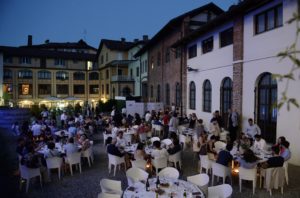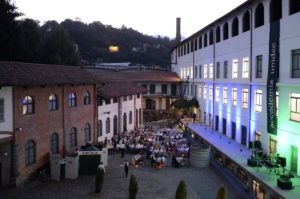Many keywords could be associated with the latest edition of Arte al Centro: creativity, culture, responsibility, innovation, research, best practices, environment and education, to name but a few. In a purely subjective view of the writer, however, the choice veers towards ‘plurality’. In fact, the proposals of the event were numerous, heterogeneous and multi-thematic, declined around the fil rouge of art and sustainability. It is neither granted nor banal that an organisation with an artistic vocation – and it is already reductive to define it only as such – can and does manage to offer so much in terms of quality and quantity in a single appointment. The event of 1 July was not a mere opening of exhibitions, but a collective and shared mosaic of the artistic practices of transformation of the social contexts in which they are developed carried out by Cittadellarte and its international network. Following in the footsteps of its own identity, Arte al Centro has once again offered inputs and examples to illustrate how art can place itself at the centre of processes of social change based on responsibility.
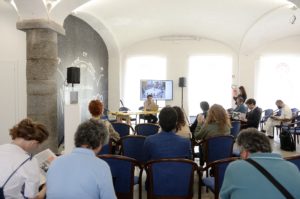
Photo by Pierluigi Di Pietro.
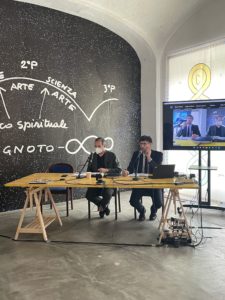
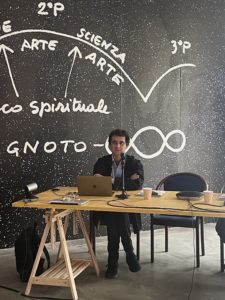
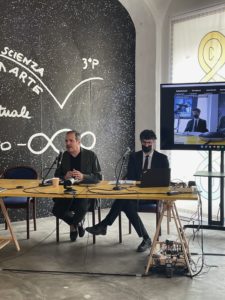
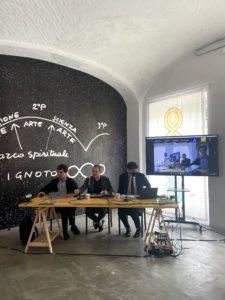
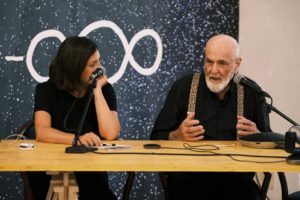
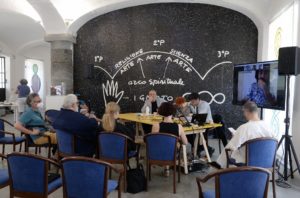
Photo by Pierluigi Di Pietro.
Public!
Rewinding the tape, the event started on 30 June with Public!¹, the two-day academic research conference curated by Accademia Unidee and dedicated to the theme of the public understood in all its meanings, from ‘everyone’s thing’, to the public sphere, to the audience taking part in the work. “What about the public? Who can define what is public? How is the idea of the public constructed? Can the public represent a form of resistance to contemporary environmental crises?”. These are just some of the key issues around which the conference was structured, which questioned how the public dimension acts in the contemporary complexity. The list of authoritative speakers who alternated and followed one another in the course of the two days included guests selected through a call for papers from the disciplines of art, sociology, economics, philosophy, architecture and narrativity. Integral part of the event, in addition to the guests’ speeches, were the (in)formal moments of dialogue and exchange – in both plenary and parallel sessions – between the speakers and the audience, which allowed to enrich, analyse and go beyond the contents of the speakers’ speeches. In addition to the team of Accademia Unidee and Cittadellarte – in the figures of Michelangelo Pistoletto, Paolo Naldini (director of Cittadellarte and president of Accademia Unidee), Francesco Monico (director of Accademia Unidee) and Michele Cerruti But (academic coordinator of Accademia Unidee) – the panel of speakers for the plenary sessions included Denis Jaromil Roio, Laura Barreca, Pierluigi Sacco, Antonio Vercellone (researcher in private law at the Department of Law of the University of Turin and professor of Principles of Private Law at the Bocconi University in Milan), as well as the Ippolita Group and Alterazioni Video.
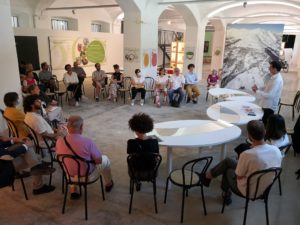
Photo by L.D.
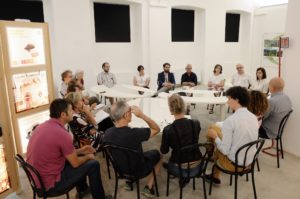
Photo by Pierluigi Di Pietro.
Biella Demopratic Città Arcipelago
One of the pivotal proposals of Arte al Centro was once again Biella Città Arcipelago Demopratico, a research project curated by Cittadellarte’s Art and Politics Office (coordinated by Paolo Naldini with the collaboration of Elisa Gilardino, Andrea Trivero, Tancredi Pino; supported by Fondazione BIellezza and Fondazione Cassa di Risparmio di Biella, in synergy with Biella Città Creativa Unesco) with an updated and expanded version of the contents of sustainability and creativity in progress in the Biella area. The new installations included the interactive model of ‘Biella Città Arcipelago’, already existing but updated with new maps and content, and a display recounting the historical evolution of the archipelago territory through a comparison between the famous aerial photographs taken by photographer and journalist Pietro Minoli between the 1950s and 1990s and the photographs of the same places taken in 2022 by Fabrizio Lava. Also new was the video installation Racconti dall’Arcipelago (Tales from the Archipelago), which reports the direct testimony of some of the 120 organizations surveyed so far in the mapping through a series of video interviews. The central room of the exhibition space now introduces the new organizations included in the mapping and presents the work started by the thematic working tables or action groups that have shared ideas and projects around the Tables of the Third Paradise, created by Michelangelo Pistoletto. The exhibition “Biella Città Arcipelago” invites visitors to reflect on the importance of active participation on the part of companies and individuals so that changes can be made in the contemporaneity of the territory they inhabit, in view of a better and sustainable future.
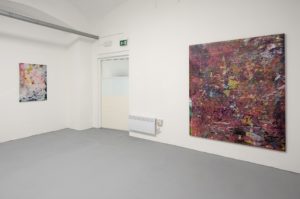
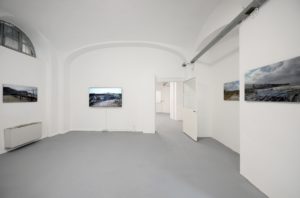
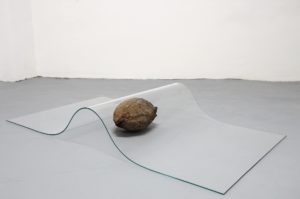
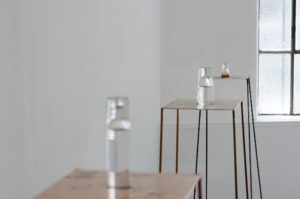
Photo by Pierluigi Di Pietro.
Quattro Pezzi (non tanto) Facili
Arte al Centro featured the opening of Quattro Pezzi (non tanto) Facili – Four (Not So) Easy Pieces, a group exhibition curated by Giorgio Verzotti in collaboration with the Woolbridge Gallery, a creative space which occupies part of the former Lanificio Pria in Biella. The relationship between Fondazione Pistoletto and the gallery directed by Jean le Guyader and Patrick Saletta was established in November 2021 with the exhibition “Zona Bianca Zero”, held at the Woolbridge Gallery and including a work by Michelangelo Pistoletto. In the spirit of fostering a collaboration between the Foundation and other art centres in Biella, Pistoletto selected some of the works created by four artists who had participated in the 2021 collective exhibition, i.e. Massimo De Caria, Daniele Innamorato, Filippo Berta, Carlo and Fabio Grassia. Quattro Pezzi (non tanto) Facili opens a dialogue between different artistic processes, including video, sculpture, drawing and painting.
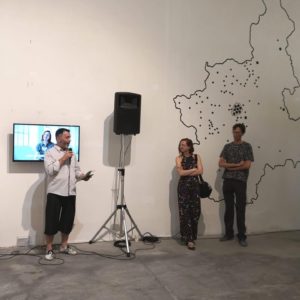
Photo by L.D.
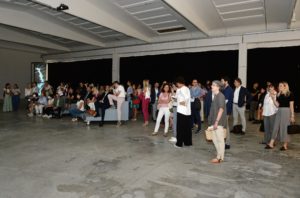
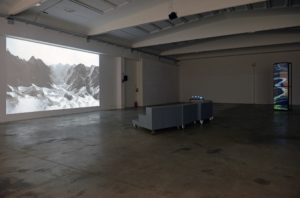

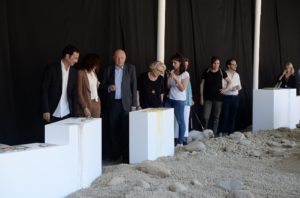
Photo by Pierluigi Di Pietro.
S+T+ARTS4Water
On 1 July, the evening started with the presentation of two artists-in-residency’s researches dedicated to the theme of water. Juan Sandoval, director of Cittadellarte’s Art Office, officially kicked off the event by presenting the final projects of artists Theresa Schubert and Joshua G. Stein, who then illustrated their own works, resulting from their residencies within the project S+T+ARTS4Water2 (2021-2022), part of S+T+ARTS (Science, Technology and the Arts), a European Commission initiative promoted within the framework of the research and innovation programme Horizon 2020 to support collaborations between artists, scientists, engineers and researchers. The project saw the two artists investigate two water-related regional challenges, defined through the involvement of a network of experts and focused on the relationship with river systems: “Exploring people’s relationships with rivers and streams” and “River systems as indicators of climate change and its impact”.
Thanks to the contribution of a rich network of professionals, researchers and local experts, the two artists worked on projects that intersect artistic research with scientific and technological research, in order to critically explore the main issues related to the management of river systems. The aim of the project S+T+ARTS4Water is to raise awareness of the need for a sustainable use of water resources in reference to the United Nations Sustainable Development Goals (SDGs) 2030. Glacier trilogy (in progress) by Theresa Schubert presents three works inspired by glaciers as the starting point of river systems, as water reservoirs, “memory” of the Earth’s past and indicators of climate change, while Joshua G. Stein’s project, entitled Dissolution | Reconstitution: Sediment as Cultural Heritage, re-imagines the western Po Valley as a territory whose hydrology is both directed by and composed of anthropogenic activities, saturated with the positive and negative aspects of human culture and development.
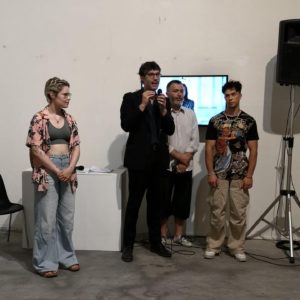
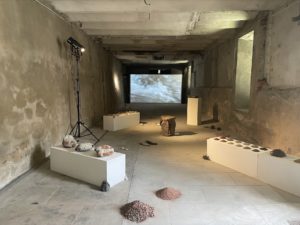
Water as infrastructure
As part of the S+T+ARTS Academy programme, Accademia Unidee launched a call open to students from academies and universities to support the production of a work of art to be exhibited at Arte al Centro. The selected proposals were developed into installations during an intensive residency at Cittadellarte, with the tutorship of artists and scholars. Water as infrastructure, the theme of the call, intended river systems as a stratification of social, historical, industrial, mining, colonial, environmental and geological issues. Dutch Levon Zoomers and Italian Davide Balda were shortlisted for the Water as infrastructure award, and their works were presented by Michele Cerruti But at the opening of Arte al Centro. “I have climbed a staircase to the top of the mountain” (video and text) is the title of the work by Levon Zoomers, who, we read in the abstract, “entered into contact with performers by asking them to act in response to a poem written in immersive moments, perceiving the strength and power of water streams. The video is a visual and sound collage that breaks the images into fragments. Each piece is a moment that the artist spent seeking a connection with people and streams, aspiring to an exchange of cultures and to learning from them what it means to be made and to be immersed in water”. Davide Balda’s work, Provenienze (Provenances), is built around natural and artificial materials found along river courses whose waters have developed violent and rapid movements over time, modifying and destroying everything around them. Territories such as Liguria, where Davide is originally from, and Biella are examples of shifting morphologies that accelerate the effects of climate change. Provenienze wants to tell the story of water processes through the creation of everyday objects made of debris, i.e. modified parts of elements of the territory.
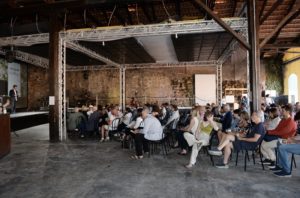
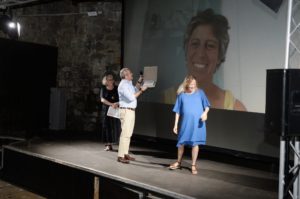

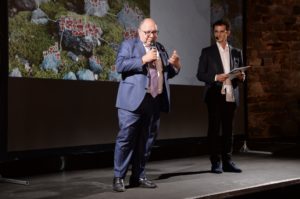
Photo by Pierluigi Di Pietro.
The opening
Arte al Centro officially opened at 6.30 pm, with a series of speeches curated and moderated by Paolo Naldini. It was an intense and immersive moment, with authorities and guest speakers in attendance, who touched on different key points related to the contents of the event. The director of Cittadellarte introduced the following guests: Claudio Corradino, Mayor of Biella; Carlo Grosso, Councillor for Culture and Tourism for the municipality of Valdilana; Chiara Caucino, Councillor for Childhood, Parenthood and the Role of the Family in Children’s Policies and Equal Opportunities for Regione Piemonte; Gilberto Pichetto Fratin, Deputy Minister for Economic Development; Cristiano Gatti, Vice-President of the CRB Foundation Steering Committee; Lorenzo Pozzo, Fondazione BIellezza; Giorgio Verzotti; Franco Coppa, representative of the Arcipelago ElettrificAction Table; Ruggero Poi, representative of the Arcipelago Education Table; Armona Pistoletto, representative of the Arcipelago Food Table; Fabrizio Lava, representative of the Arcipelago Hospitality Table; Andrea Polidori, representative of the Arcipelago Water Table. Francesco Monico and Michele Cerruti But then offered a restitution of the two days of Public! and, as part of Accademia Unidee, Sofia Ferrarese, master’s and bachelor’s student, also spoke. Closing the event was Cittadellarte’s president Giuliana Setari, who, together with Paolo Naldini, presented the Minimum Prize to Monika Wuhrer, connected on Zoom³ (all details in an article we will publish in the next few days). This was followed by an evening of conviviality and healthy, natural and local food, with a Let Eat Bi dinner proposed by Cittadellarte’s restaurant Al Bistrot le Arti. The evening continued until midnight, with music from DJ Lego My Ego and Sala_Macchine Crew represented by Marco Cassisa, and guided tours of the cultural and artistic proposals set up in the evocative spaces of Fondazione Pistoletto. The curtain then fell on the day: on Friday evening, once again, art and sustainability once more saw the stars.

